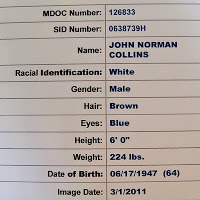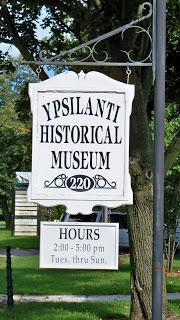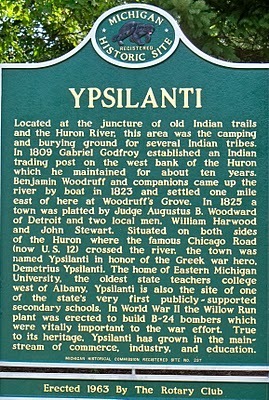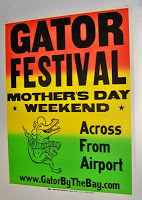Gregory A. Fournier's Blog, page 61
October 2, 2011
The John Norman Collins House
One of the most surprising and disturbing discoveries on my recent trip to Ypsilanti, Michigan, was that the house where John Norman Collins lived and may have committed unspeakable crimes against young women forty-five years ago, is now occupied by a sorority. I'm told that in 1990-91, a dormitory wing was added to convert the original home, built in 1870, into the Alpha Xi Delta house just south of Eastern Michigan University's campus.
 I noticed one of the young women was on the porch getting mail, so I cautiously approached with my researcher, Yog Sothoth, who was beside me. "Hello! Can I talk to you for a minute?"
I noticed one of the young women was on the porch getting mail, so I cautiously approached with my researcher, Yog Sothoth, who was beside me. "Hello! Can I talk to you for a minute?"
"Sure," she said.
"Do you know any history of the house you're living in?"
She answered, "I think so.
Then we started talking. Two of her sorority sisters came out and joined us. I told them I was writing a book about the John Norman Collins "Coed Killer" case, and they opened right up to me, a total stranger with a story. I was there with another male, and that didn't send up a red flag.
Considering the subject matter of my research, the serial killing and sexual mutilation of seven young women in Washtenaw County, I would have expected these young women would have been more guarded with me. It bothered me that they weren't.
After examining the case, I don't think John Norman Collins was as clever as many people gave him credit to be; it is just that too many people are naive or stupid. That neighborhood is still murky at night and gives me the creeps to this day. Over this summer, Ann Arbor was plagued with a series of assaults and rapes on young U of M women walking alone at night, on or around campus.
Caution and situational awareness is everybody's business. Women, when you are out in public, predators look for weakness and advantage; then, they choose their moment and killing ground. When you walk or jog alone with ear buds that impair your ability to hear what is going on around you, that sends a flag up that you are vulnerable. Your music or cell phone call can wait.

 Walking in high heels also marks you as a potential victim, especially if your are walking alone on a quiet street. The tapping of your heels can announce that you are by yourself, even before a would be attacker has you in his sight. Heels also hamper your ability to flee.
Walking in high heels also marks you as a potential victim, especially if your are walking alone on a quiet street. The tapping of your heels can announce that you are by yourself, even before a would be attacker has you in his sight. Heels also hamper your ability to flee.
Common sense is your first line of defense. Tune into where you are and what is going on around you. Avoid becoming another statistic.
 I noticed one of the young women was on the porch getting mail, so I cautiously approached with my researcher, Yog Sothoth, who was beside me. "Hello! Can I talk to you for a minute?"
I noticed one of the young women was on the porch getting mail, so I cautiously approached with my researcher, Yog Sothoth, who was beside me. "Hello! Can I talk to you for a minute?""Sure," she said.
"Do you know any history of the house you're living in?"
She answered, "I think so.
Then we started talking. Two of her sorority sisters came out and joined us. I told them I was writing a book about the John Norman Collins "Coed Killer" case, and they opened right up to me, a total stranger with a story. I was there with another male, and that didn't send up a red flag.
Considering the subject matter of my research, the serial killing and sexual mutilation of seven young women in Washtenaw County, I would have expected these young women would have been more guarded with me. It bothered me that they weren't.
After examining the case, I don't think John Norman Collins was as clever as many people gave him credit to be; it is just that too many people are naive or stupid. That neighborhood is still murky at night and gives me the creeps to this day. Over this summer, Ann Arbor was plagued with a series of assaults and rapes on young U of M women walking alone at night, on or around campus.
Caution and situational awareness is everybody's business. Women, when you are out in public, predators look for weakness and advantage; then, they choose their moment and killing ground. When you walk or jog alone with ear buds that impair your ability to hear what is going on around you, that sends a flag up that you are vulnerable. Your music or cell phone call can wait.

 Walking in high heels also marks you as a potential victim, especially if your are walking alone on a quiet street. The tapping of your heels can announce that you are by yourself, even before a would be attacker has you in his sight. Heels also hamper your ability to flee.
Walking in high heels also marks you as a potential victim, especially if your are walking alone on a quiet street. The tapping of your heels can announce that you are by yourself, even before a would be attacker has you in his sight. Heels also hamper your ability to flee.Common sense is your first line of defense. Tune into where you are and what is going on around you. Avoid becoming another statistic.
Published on October 02, 2011 15:43
September 30, 2011
In the Shadow of the Water Tower
 My trip to Ypsilanti, Michigan in September, to research the John Norman Collins Washtenaw County killings, was more productive than I could have imagined. In addition to a wide variety of materials I had gleaned from the internet, my Michigan researcher, Yog Sothoth, presented me with two huge folders of photocopies of virtually every newspaper article written in the state about this case and its aftermath.
My trip to Ypsilanti, Michigan in September, to research the John Norman Collins Washtenaw County killings, was more productive than I could have imagined. In addition to a wide variety of materials I had gleaned from the internet, my Michigan researcher, Yog Sothoth, presented me with two huge folders of photocopies of virtually every newspaper article written in the state about this case and its aftermath.After we briefly scanned and discussed his research, Yog and I went to visit the Ypsilanti Archives in that city's Historical Museum. Once I explained our mission to the archivists, they were falling all over themselves to be helpful.
I had been trying to locate a former English professor of mine, from Eastern Michigan University, who was writing a factual account of the murders forty years ago and lent Edward Keyes, the author of The Michigan Murders, his notes on the case.
Unsuccessful in finding the good professor, I mentioned that to George, one of the volunteers at the archives. He told me an EMU prof was just here last week researching this very topic.
"His name wasn't, Paul McGlynn, was it?"
 To make a long story short, George had his email address and contacted him, and McGlynn contacted me. What luck! But not so fast, it seems that my former professor and I are competitors. He still has plans to publish, but our treatments of the subject matter will be materially different. Not bad for my first day of researching in Michigan.
To make a long story short, George had his email address and contacted him, and McGlynn contacted me. What luck! But not so fast, it seems that my former professor and I are competitors. He still has plans to publish, but our treatments of the subject matter will be materially different. Not bad for my first day of researching in Michigan. This case still incites people's interest because five of the seven murders attributed to the "coed killer," from the summer of 1967 through the summer of 1969, were left unsolved and are cold case murders. John Norman Collins was arrested and convicted of only a single count of murder and sexual assault for the brutal slaying of Karen Sue Beineman.
The rest of my week was devoted to interviewing people who knew John Collins way back when and who were never interviewed. I discovered some very interesting things. Next time....
Published on September 30, 2011 10:14
September 16, 2011
The Water Tower - Digging up the Past
Hello from Washtenaw County, home of The University of Michigan and Eastern Michigan University. I am in Michigan doing research for my next writing project, which has the working title of The Water Tower. From July of 1967 until July of 1969, a phantom killer left two college campuses in a state of sustained fear and terror.
 John Norman Collins is reputed to have tortured, murdered and mutilated seven young woman from the AnnArbor/Ypsilanti area. He was convicted of only one of the murders, but many questions have been left unanswered in the rush to get him off the streets before he could strike again.
John Norman Collins is reputed to have tortured, murdered and mutilated seven young woman from the AnnArbor/Ypsilanti area. He was convicted of only one of the murders, but many questions have been left unanswered in the rush to get him off the streets before he could strike again.
There is a strong feeling that Collins did not always act alone. Did he have an accomplice? Is that person still out roaming among us? Surely someone else was at least aware or suspected that Collins might be the guilty party.
And then there are those who believe in the innocence of John Norman Collins after all these years. The suspected psychopath, a clean cut Catholic kid from Centerline, Michigan? It couldn't be.
Several people have come forward with new information regarding this case. There is more story here and I mean to tell it.
 John Norman Collins is reputed to have tortured, murdered and mutilated seven young woman from the AnnArbor/Ypsilanti area. He was convicted of only one of the murders, but many questions have been left unanswered in the rush to get him off the streets before he could strike again.
John Norman Collins is reputed to have tortured, murdered and mutilated seven young woman from the AnnArbor/Ypsilanti area. He was convicted of only one of the murders, but many questions have been left unanswered in the rush to get him off the streets before he could strike again.There is a strong feeling that Collins did not always act alone. Did he have an accomplice? Is that person still out roaming among us? Surely someone else was at least aware or suspected that Collins might be the guilty party.
And then there are those who believe in the innocence of John Norman Collins after all these years. The suspected psychopath, a clean cut Catholic kid from Centerline, Michigan? It couldn't be.
Several people have come forward with new information regarding this case. There is more story here and I mean to tell it.
Published on September 16, 2011 00:00
September 9, 2011
Zug Island: A Detroit Riot Novel?

Several readers of my novel have mentioned that they thought my story would be primarily about the Detroit Riots. From a first-person vantage point, only a slice of that story can be told, which is self-limiting.
I chose to summarize the riots in one chapter with a third-person, documentary style gleaned from the television coverage of the time, not a retrospective. The point of view alternates from first to third person in this chapter.
My novel speaks to the suburban piece of the riot puzzle, which is usually overlooked or simply ignored, and it gives some historical context to help explain Detroit's troubled racial landscape.
For those readers who want more riot material, here is Gordon Lightfoot performing "Black Day in July" with Detroit Riot footage.
http://youtu.be/DPXL3iEVnCM
Published on September 09, 2011 06:38
September 1, 2011
I'll Have Some Cheeze with That Whine
Had an on-camera author interview for my novel, Zug Island, in LA yesterday. After a lovely afternoon of fighting the Southern Calfornian traffic for three hours from San Diego and finding a parking space near LAX, my time had come.
Lights, camera, sound check, the interviewer was totally unprepared. He must have confused me with someone else he had to interview. He asked me about adapting plays. ??? Good thing I had written one twenty years ago, Crime and Punishment, so I talked about that. Whew! Shall I tell you about the ride home at rush hour on the 405?
Wait!!! It just occurred to me that many people back East have real problems to deal with right now. Many people don't even have a road to drive on this week after hurricane Irene, and many people lost their lives. My apology and sympathy to all those who have suffered this past week. I urge everyone to donate money to the Red Cross and give these people some help.
 redcross.org
redcross.org
Lights, camera, sound check, the interviewer was totally unprepared. He must have confused me with someone else he had to interview. He asked me about adapting plays. ??? Good thing I had written one twenty years ago, Crime and Punishment, so I talked about that. Whew! Shall I tell you about the ride home at rush hour on the 405?
Wait!!! It just occurred to me that many people back East have real problems to deal with right now. Many people don't even have a road to drive on this week after hurricane Irene, and many people lost their lives. My apology and sympathy to all those who have suffered this past week. I urge everyone to donate money to the Red Cross and give these people some help.
 redcross.org
redcross.org
Published on September 01, 2011 21:59
August 26, 2011
Grandma Was Just That Way
Sometime in the late1920's, my grandmother and grandfather moved North from Tennessee looking for work. My grandfather found work at GM. He died before I was born. When I was a youngster in Detroit, I remember my grandmother working at Crowley's Department Store decorating cakes for a living. After she had a stroke on a downtown street after work one day, she was left paralyzed on her right side, so she moved to Arkansas and was attended to by a black woman who was every bit as old as she was.
My brother and I spent several summers on "vacations" with our parents visiting my grandmother in Elaine, Arkansas, in the early sixties. The film, The Help, reminded me of seeing the colored cafes and white-only drinking fountains in the small town.The one movie theater in Elaine had a separate entrance for blacks which led to the balcony. The white kids went through the front door and sat on the ground floor. These things do not exist anymore, but it wasn't that long ago when they did. I can bear witness to it.
Back to my grandmother: she lived in a rickety, clapboard house with wall paper, peeling from the humidity off the nearby Mississippi River. The house was across the street from the area's cotton gin and storage silos, where Uncle Ivo worked as the manager of the operation by day. Throughout the daylight hours, Miss Elizabeth, a black woman in her sixties, waited on my grandmother's beck and call. She was my grandmother's constant companion and attendant, until Uncle Ivo got home from the cotton gin later in the day.
"Just ask Miss Elizabeth for anything you want," my grandmother would say. "She'll make you a sandwich or a milk shake. Whatever you're partial to."
Miss Elizabeth didn't say much, but she smiled a lot. Between taking care of my grandma's personal hygiene needs, and feeding four extra people in the household, she sat quietly off to the side, or in the kitchen, gently rocking while cross stitching samplers or mending old clothes.
 Having us there wasn't a bother for her. My mother cooked us dinners while we were there, and Miss Elizabeth could go home early on most days when we were there. She would grab her bag of stuff and trek almost a mile down the road to another house that looked more like a shack, with a houseful of family sitting around, and she was glad to be home. Her only day off was Sunday, which she spent at church with her family and friends.
Having us there wasn't a bother for her. My mother cooked us dinners while we were there, and Miss Elizabeth could go home early on most days when we were there. She would grab her bag of stuff and trek almost a mile down the road to another house that looked more like a shack, with a houseful of family sitting around, and she was glad to be home. Her only day off was Sunday, which she spent at church with her family and friends.
"I don't know what I'd do without Miss Elizabeth," I remember Grandma saying. "I can't go to church anymore, so she reads the good book to me, and it soothes me."
Reading the Bible was the least of the services Miss Elizabeth performed for her in the course of a long day.
My mother couldn't help but ask. "How much do you pay her?"
"Forty dollars cash a month, under the table, and she's glad to get it."
"That's very reasonable considering everything she does for you, Mother."
"It's a good thing I'm a God fearing Christian woman. Who else would hire an old nigger woman like that?"
What ingratitude! I thought. Even as a kid, I was struck by her matter-of-fact, racist attitude.
But by the standards of her community, in her day, she believed she was being charitable. Sad but true. Well, those days are mostly over, thank goodness.
Not since the novel and the film, The Autobiography of Miss Jane Pittman, has this ugly reality been depicted with such humanity and humility than in The Help. I urge everyone to see this film while it's still in theaters. It has Oscar written all over it.

My brother and I spent several summers on "vacations" with our parents visiting my grandmother in Elaine, Arkansas, in the early sixties. The film, The Help, reminded me of seeing the colored cafes and white-only drinking fountains in the small town.The one movie theater in Elaine had a separate entrance for blacks which led to the balcony. The white kids went through the front door and sat on the ground floor. These things do not exist anymore, but it wasn't that long ago when they did. I can bear witness to it.
Back to my grandmother: she lived in a rickety, clapboard house with wall paper, peeling from the humidity off the nearby Mississippi River. The house was across the street from the area's cotton gin and storage silos, where Uncle Ivo worked as the manager of the operation by day. Throughout the daylight hours, Miss Elizabeth, a black woman in her sixties, waited on my grandmother's beck and call. She was my grandmother's constant companion and attendant, until Uncle Ivo got home from the cotton gin later in the day.
"Just ask Miss Elizabeth for anything you want," my grandmother would say. "She'll make you a sandwich or a milk shake. Whatever you're partial to."
Miss Elizabeth didn't say much, but she smiled a lot. Between taking care of my grandma's personal hygiene needs, and feeding four extra people in the household, she sat quietly off to the side, or in the kitchen, gently rocking while cross stitching samplers or mending old clothes.
 Having us there wasn't a bother for her. My mother cooked us dinners while we were there, and Miss Elizabeth could go home early on most days when we were there. She would grab her bag of stuff and trek almost a mile down the road to another house that looked more like a shack, with a houseful of family sitting around, and she was glad to be home. Her only day off was Sunday, which she spent at church with her family and friends.
Having us there wasn't a bother for her. My mother cooked us dinners while we were there, and Miss Elizabeth could go home early on most days when we were there. She would grab her bag of stuff and trek almost a mile down the road to another house that looked more like a shack, with a houseful of family sitting around, and she was glad to be home. Her only day off was Sunday, which she spent at church with her family and friends."I don't know what I'd do without Miss Elizabeth," I remember Grandma saying. "I can't go to church anymore, so she reads the good book to me, and it soothes me."
Reading the Bible was the least of the services Miss Elizabeth performed for her in the course of a long day.
My mother couldn't help but ask. "How much do you pay her?"
"Forty dollars cash a month, under the table, and she's glad to get it."
"That's very reasonable considering everything she does for you, Mother."
"It's a good thing I'm a God fearing Christian woman. Who else would hire an old nigger woman like that?"
What ingratitude! I thought. Even as a kid, I was struck by her matter-of-fact, racist attitude.
But by the standards of her community, in her day, she believed she was being charitable. Sad but true. Well, those days are mostly over, thank goodness.
Not since the novel and the film, The Autobiography of Miss Jane Pittman, has this ugly reality been depicted with such humanity and humility than in The Help. I urge everyone to see this film while it's still in theaters. It has Oscar written all over it.
Published on August 26, 2011 00:00
August 23, 2011
The Help - There Is a Difference Between Service and Servitude
My wife and I saw The Help over the weekend and found it to be a moving and an enjoyable film. It depicts an era in American history which will soon be lost to living memory. I know. I'm getting older and I remember the way it was. My brother and I spent several summers in Arkansas in the early 1960s and saw Jim Crow at work in the sleepy cotton town of Elaine.
To find humor from the black perspective in the South during the Jim Crow days isn't easy, but to find heart, soul, and a relevant message delivered in an impeccable period piece is even rarer. This film portrays upper crust, Southern Americana, with a mud pie and a whipped creme dollop on top! All that chocolate, supporting a fluffy, white confection, an apt metaphor. Brilliant!
This film shows the heart wrenching sacrifices these brave ladies made for their families and the injustices they endured against themselves, in an era when a misplaced look or a muttered word could get you fired or lynched.
 The struggle for civil rights has been a long, hard battle in this country, and like all great battles, it is made up of one campaign after another, fought over time across the vast American landscape. It is made up of millions of smaller skirmishes, whose victim's wounds go untended and unredressed.
The struggle for civil rights has been a long, hard battle in this country, and like all great battles, it is made up of one campaign after another, fought over time across the vast American landscape. It is made up of millions of smaller skirmishes, whose victim's wounds go untended and unredressed.
The dehumanization and intimidation of another human being, to support a corrupt class system, is despicable. For those who say this movie is an exaggeration, open a history book or google the Civil Rights Movement. This film puts a face on the outrage perpetrated against these ladies, and honors every woman who ever put on the maid's starched uniform.
The Help made me remember something sad about my maternal grandmother....
Next time!

To find humor from the black perspective in the South during the Jim Crow days isn't easy, but to find heart, soul, and a relevant message delivered in an impeccable period piece is even rarer. This film portrays upper crust, Southern Americana, with a mud pie and a whipped creme dollop on top! All that chocolate, supporting a fluffy, white confection, an apt metaphor. Brilliant!
This film shows the heart wrenching sacrifices these brave ladies made for their families and the injustices they endured against themselves, in an era when a misplaced look or a muttered word could get you fired or lynched.
 The struggle for civil rights has been a long, hard battle in this country, and like all great battles, it is made up of one campaign after another, fought over time across the vast American landscape. It is made up of millions of smaller skirmishes, whose victim's wounds go untended and unredressed.
The struggle for civil rights has been a long, hard battle in this country, and like all great battles, it is made up of one campaign after another, fought over time across the vast American landscape. It is made up of millions of smaller skirmishes, whose victim's wounds go untended and unredressed. The dehumanization and intimidation of another human being, to support a corrupt class system, is despicable. For those who say this movie is an exaggeration, open a history book or google the Civil Rights Movement. This film puts a face on the outrage perpetrated against these ladies, and honors every woman who ever put on the maid's starched uniform.
The Help made me remember something sad about my maternal grandmother....
Next time!
Published on August 23, 2011 14:34
August 19, 2011
August 15, 2011
Zydeco Culture and Gator by the Bay
The music and dance style that sprang out of West Louisiana, known as zydeco, has its roots in Cajun music and the Cajun two-step jig, also called the Louisiana Limp. In 1755, the English, who now owned Canada, expelled the French Canadians for refusing to pledge allegiance to the English crown. Many of these people migrated to Louisiana and became the Cajun people.
 Some say zydeco's roots run deeper than that, all the way to Africa from slaves who held tightly to their music and culture, and to the Caribbean with rhythms imported from Haiti, after a slave rebellion there.
Some say zydeco's roots run deeper than that, all the way to Africa from slaves who held tightly to their music and culture, and to the Caribbean with rhythms imported from Haiti, after a slave rebellion there.
With the addition of the accordion to establish a vigorous, syncopated rhythm, a metal corrugated rub board (once a common wash board), and the fiddles taking a background role or none at all, the Cajun music took off in another direction and a new sound was born. Then, in the 1950s, a blues player named Clifton Chenier added amplified instruments and recorded his music - zydeco music he called it - and the local people loved it. Then it spread.
Modern zydeco music is thriving in big cities and small towns across much of America. There is even a group of zydeco dancers in London, England. The basic sound has evolved and been influenced by pop music, hard rock, rap, reggae, and hip hop. The music has a joyful and happy sound, but it can also be bluesy, soulful, and sad. The rhythm is always vibrant and infectious.
This is music that makes people want to get up and dance. The basic foot movement is slow-quick-quick-slow, with or without a rock step. In California, where there is a strong swing dance influence, many dancers use the rock step like in East Coast Swing. Zydeco is more fundamental than swing dancing and easier to do. That is one reason why it is so popular. A person can get out on the dance floor with very little instruction or practice and have a great time.
Zydeco music was looked down upon by the New Orleans music establishment as bayou or swamp music, for decades. Not until Buckwheat Zydeco and Beau Jocque, and others, started making money, getting radio airplay, drawing big crowds, and getting media attention did they invite their country cousins into the New Orleans musical family. But make no mistake about it, the epicenter of zydeco music is still Lafayette and the surrounding area.
In San Diego, we have an active zydeco dance club named Bon Temps (Good Times) that hosts a weekly dance of zydeco and Cajun music, and on the second Saturday of each month, the club gives free lessons and holds dances with a live band. Some of the bands come from Louisiana, while others are home grown like Theo and the Zydeco Patrol, The Swamp Critters, The Bayou Brothers, and the San Diego Cajun Playboys.
 Bon Temps organizes a yearly event every May over Mother's Day weekend called Gator by the Bay, which draws over 6,000 people. It is held on San Diego Bay at Spanish Landing. Two full days of music and dancing on two large dance floors. One of the 2,160 square foot dance floors is primarily for Zydeco/Cajun performers and the other is for blues, jazz and contemporary music acts.
Bon Temps organizes a yearly event every May over Mother's Day weekend called Gator by the Bay, which draws over 6,000 people. It is held on San Diego Bay at Spanish Landing. Two full days of music and dancing on two large dance floors. One of the 2,160 square foot dance floors is primarily for Zydeco/Cajun performers and the other is for blues, jazz and contemporary music acts.
There is something for everyone. For a taste of Louisiana, the food court serves up jambalaya, crayfish, gumbo, roast turkey legs, and lots more. Throughout both festival days, dance lessons from top instructors in several styles of dancing are given for free.
Not a bad way to spend Mother's Day. Put the Gator by the Bay festival on your calendar for May 2012. You'll be glad you did. This is a family friendly event.
Laissez les bon temp rouler!
For more information, check out HTTP://LouisianaDance.com
or www.gatorbythebay.com.

 Some say zydeco's roots run deeper than that, all the way to Africa from slaves who held tightly to their music and culture, and to the Caribbean with rhythms imported from Haiti, after a slave rebellion there.
Some say zydeco's roots run deeper than that, all the way to Africa from slaves who held tightly to their music and culture, and to the Caribbean with rhythms imported from Haiti, after a slave rebellion there.With the addition of the accordion to establish a vigorous, syncopated rhythm, a metal corrugated rub board (once a common wash board), and the fiddles taking a background role or none at all, the Cajun music took off in another direction and a new sound was born. Then, in the 1950s, a blues player named Clifton Chenier added amplified instruments and recorded his music - zydeco music he called it - and the local people loved it. Then it spread.
Modern zydeco music is thriving in big cities and small towns across much of America. There is even a group of zydeco dancers in London, England. The basic sound has evolved and been influenced by pop music, hard rock, rap, reggae, and hip hop. The music has a joyful and happy sound, but it can also be bluesy, soulful, and sad. The rhythm is always vibrant and infectious.
This is music that makes people want to get up and dance. The basic foot movement is slow-quick-quick-slow, with or without a rock step. In California, where there is a strong swing dance influence, many dancers use the rock step like in East Coast Swing. Zydeco is more fundamental than swing dancing and easier to do. That is one reason why it is so popular. A person can get out on the dance floor with very little instruction or practice and have a great time.
Zydeco music was looked down upon by the New Orleans music establishment as bayou or swamp music, for decades. Not until Buckwheat Zydeco and Beau Jocque, and others, started making money, getting radio airplay, drawing big crowds, and getting media attention did they invite their country cousins into the New Orleans musical family. But make no mistake about it, the epicenter of zydeco music is still Lafayette and the surrounding area.
In San Diego, we have an active zydeco dance club named Bon Temps (Good Times) that hosts a weekly dance of zydeco and Cajun music, and on the second Saturday of each month, the club gives free lessons and holds dances with a live band. Some of the bands come from Louisiana, while others are home grown like Theo and the Zydeco Patrol, The Swamp Critters, The Bayou Brothers, and the San Diego Cajun Playboys.
 Bon Temps organizes a yearly event every May over Mother's Day weekend called Gator by the Bay, which draws over 6,000 people. It is held on San Diego Bay at Spanish Landing. Two full days of music and dancing on two large dance floors. One of the 2,160 square foot dance floors is primarily for Zydeco/Cajun performers and the other is for blues, jazz and contemporary music acts.
Bon Temps organizes a yearly event every May over Mother's Day weekend called Gator by the Bay, which draws over 6,000 people. It is held on San Diego Bay at Spanish Landing. Two full days of music and dancing on two large dance floors. One of the 2,160 square foot dance floors is primarily for Zydeco/Cajun performers and the other is for blues, jazz and contemporary music acts.There is something for everyone. For a taste of Louisiana, the food court serves up jambalaya, crayfish, gumbo, roast turkey legs, and lots more. Throughout both festival days, dance lessons from top instructors in several styles of dancing are given for free.
Not a bad way to spend Mother's Day. Put the Gator by the Bay festival on your calendar for May 2012. You'll be glad you did. This is a family friendly event.
Laissez les bon temp rouler!
For more information, check out HTTP://LouisianaDance.com
or www.gatorbythebay.com.
Published on August 15, 2011 10:41
August 11, 2011
Take Me Back To The Sixties
Published on August 11, 2011 12:11



